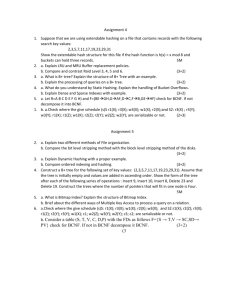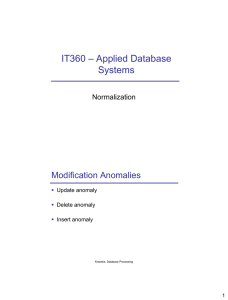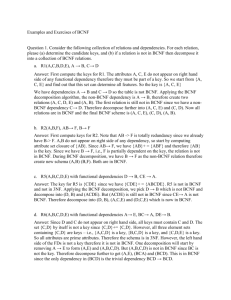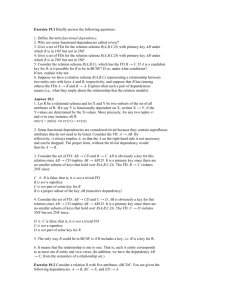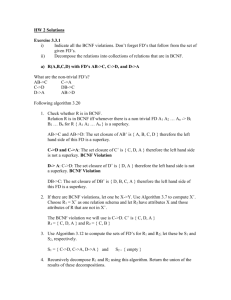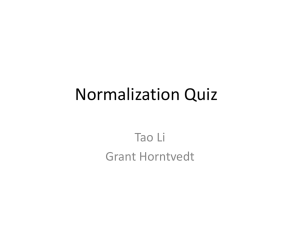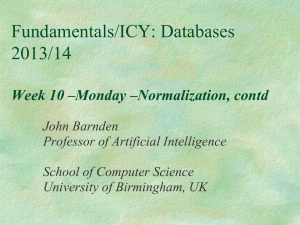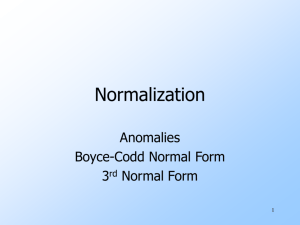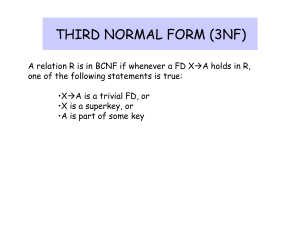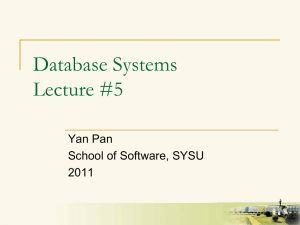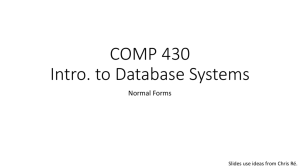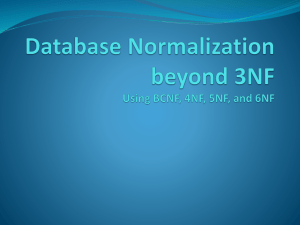Practice problems
advertisement
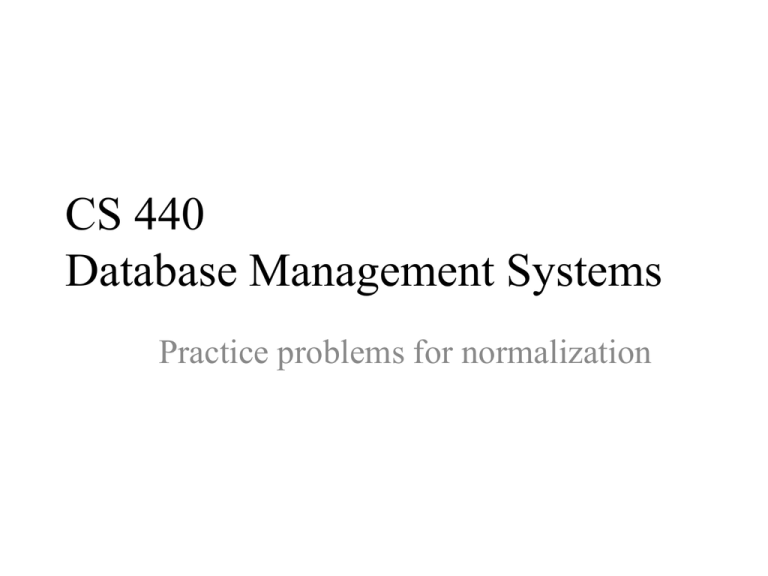
CS 440
Database Management Systems
Practice problems for normalization
Question 1: FD & key
Consider a relation R(A,B,C,D,E) with FD's, S={AB C, CD E,
C A, C D, D B}:
a) Determine all the keys of relation R.
Do not list super keys that are not a minimal key.
Solution:
• Keys: AB, AD, C
• To get the key AB, we can do the following:
– From AB C and C D, we obtain AB D.
– From AB C and AB D, we obtain AB CD.
– From AB CD and CD E, we obtain AB E.
Question 1 (Solution Contd..)
• To get the key AD, we can do the following:
– From D B, we can get AD AB.
– From AB, we can obtain the rest of the attributes.
• To get the key C, we can do the following:
– From C A and C B, we obtained C AB.
– From AB, we can obtain the rest of the attributes.
Question 2: FD
Consider a relation R(A, B, C, D, E, F) with the following set of
FD’s : S:{ ABC, CDE, B D, EA, CFB}
a) Give an example of FD that follows from S and explain your
answer.
Solution:
AB D, D is in the closure of AB. Because A B and B D Thus
AB D is a valid FD that follows S.
Question 2(Solution Contd..)
Consider a relation R(A, B, C, D, E, F) with the following
set of FD’s : S:{ ABC, CDE, B D, EA, CFB}
b) Give an example of FD that does not follow from S and
explain your answer.
Solution:
• B C, C is not in the closure of B. B doesn’t uniquely
identify C accordance to S. So, BC is not valid
accordance to S.
Question 3: BCNF
• Consider relation R (A, B, C) with a set of FDs
F={AB → C, C→A}.
determine whether R is in BCNF.
Solution:
• The keys are AB and BC.
• R is not in BCNF since left hand side of
C→A is not a super key.
Question 4: BCNF
Consider the relation schema R(A, B, C, D, E) with FD’s,
A BCDE, C D, and CE B . Decompose the relation till
it follows BCNF .
Solution:
• R is not in BCNF because CE B and CE is not a super key.
• Decompose R: R1= {CEB}, R2={ACDE}
• R1 is in BCNF
• R2 is not in BCNF, because C D and C is not a super key
• Decompose R2: R21= {C,D} , R22={A,C,E}
• R1,R21,R22 are in BCNF.
Question 5: BCNF
Consider a relation R=(A,B,C,D,E) with the following functional
dependencies, S= {BC ADE, D B}.
a) Find all candidate keys.
Solution:
The keys are {B,C} and {C,D}.
•
{B,C} is a key from BC ADE.
•
To get the key {C,D}:
from D B we get B, with B and C we have BC ADE.
Question 5 (Contd..)
Consider a relation R=(A,B,C,D,E) with the following functional
dependencies, S= {BC ADE,D B}.
b) Identify whether or not R is in BCNF.
Solution:
The relation is not BCNF because D is not a super key which
violates BCNF.
Question 6: BCNF
Consider a relation R = (A,B,C,D,E) with the following functional
dependencies, S= {CE D,D B,C A}.
a) Find all candidate keys.
Solution:
The only key is {C,E}
• To get the key CE, we can do the following:
– From CE D and D B, we obtain CE B.
– From CE D and C A, we obtain CE AD.
Question 6 (Contd..)
Consider a relation R = (A,B,C,D,E) with S = {CE D,D B,C A}.
b) If the relation is not in BCNF, decompose it until it becomes BCNF.
Solution:
Relation R is not in BCNF.
Step 1: Decomposes R into R1=(A,C) and R2=(B,C,D,E).
Resulting R1 is in BCNF. R2 is not.
Step 2: Decompose R2 into, R21=(C,D,E) and R22=(B,D).
Both relations are in BCNF.
